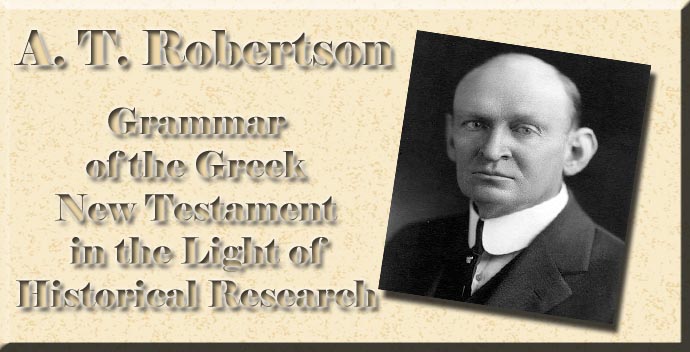
Grammar of the Greek New Testament in the Light of Historical Research
By A. T. Robertson
Preface to Second Edition
|
THE second edition has been called for so soon that I did not have the opportunity for rest that I desired before preparing for it. But I have gone steadily through the book with eager eyes. The result is that some five hundred changes have been made in the text here and there, all for the improvement of the book in one way or another, besides the Addenda at the end of the book. Most of the changes are small details, but they are all worth making. The Addenda are as few as possible because of the great size of the volume. I have been more than gratified at the kindly reception accorded the book all over the world in spite of the distraction of the dreadful war. Many scholars have offered helpful criticisms for which I am deeply grateful. In particular I wish to mention Prof. C. M. Cobern, Allegheny College, Meadville, Penn.; Prof. D. F. Estes, Colgate University, Hamilton, N. Y.; Prof. Basil L. Gildersleeve, The Johns Hopkins University, Baltimore; Prof. E. J. Goodspeed, the University of Chicago; Prof. D. A. Hayes, Garrett Biblical Institute, Evanston, Ill.; Prof. James Moffatt, Mansfield College, Oxford, England; Prof. C. W. Peppler, Trinity College, Durham, N. C.; Prof. W. Petersen, Bethany College, Lindsborg; Kansas; Mr. William Pitfield, Manchester, England; Rev. Dr. Alfred Plummer, Bideford, England; Mr. H. Scott, Birkenhead, England; Prof. James Stalker, United Free Church College, Aberdeen, Scotland; Dr. Gross Alexander, Nashville, Tenn. I hope that future editions may make it possible to improve the book still further. Various minor repetitions have been removed, though more still remain than is necessary. But the book is at least made more intelligible thereby. The numerous cross-references help also. In the Neutestamentliche Studien (1914) in honour of the seventieth birthday of Dr. Georg Heinrici of the University of Leipzig there is a paper by Heinrich Schlosser "Zur Geschichte der biblischen Philologie." He tells the story of "the first grammar of the New Testament Greek" (1655). It is by Georg Pasor and is entitled Grammatica Graeca Sacra Novi Testamenti Domini nostri Jesu Christi. His son, Matthias Pasor, Professor of Theology at Groningen, found his father's manuscript and let it lie for eighteen years because many held grammatical study to be puerile or pedantic and the book would have few readers. Finally he published it in 1655, since he held grammar to be "clavis scientiarum omnisque soliclae eruditionis basis ac fundamentum." He was cheered by Melanchthon's "fine word": "Theologia vera est grammatica quaedam divinae vocis." It is only 260 years since 1655.New books continue to come out that throw light on the language of the New Testament. Part I (through a) of Moulton and Milligan's Vocabulary of the Greek Testament Illustrated from the Papyri and Other Non-literary Sources (1914) is now a rich treasure in the hands of students. Sharp's Epictetus and the New Testament (1914) is a very helpful monograph full of suggestions. A note from Dr. Albert Thumb announces that he is at work on a revision of his Hellenismus. So the good work goes on.
A. T. ROBERTSON.
AUGUST, 1915.
|
|
 |
 |
|
|
|
Book Navigation
Title Page
Preface
Preface to 2nd Edition
Preface to 3rd Edition
Most Often Referred
Additional Bibliography
Table of Contents
Part I - Introduction
► Chapter 1
► Chapter 2
► Chapter 3
► Chapter 4
Part II - Accidence
► Chapter 5
► Chapter 6
► Chapter 7
► Chapter 8
Part III - Syntax
► Chapter 9
► Chapter 10
► Chapter 11
► Chapter 12
► Chapter 13
► Chapter 14
► Chapter 15
► Chapter 16
► Chapter 17
► Chapter 18
► Chapter 19
► Chapter 20
► Chapter 21
► Chapter 22
Additional Notes
-
Site Navigation
 Home
Home What's New
What's New Bible
Bible Photos
Photos Hiking
Hiking E-Books
E-Books Genealogy
Genealogy Profile
Free Plug-ins You May Need
Profile
Free Plug-ins You May Need
 Get Java
Get Java.png) Get Flash
Get Flash Get 7-Zip
Get 7-Zip Get Acrobat Reader
Get Acrobat Reader Get TheWORD
Get TheWORD